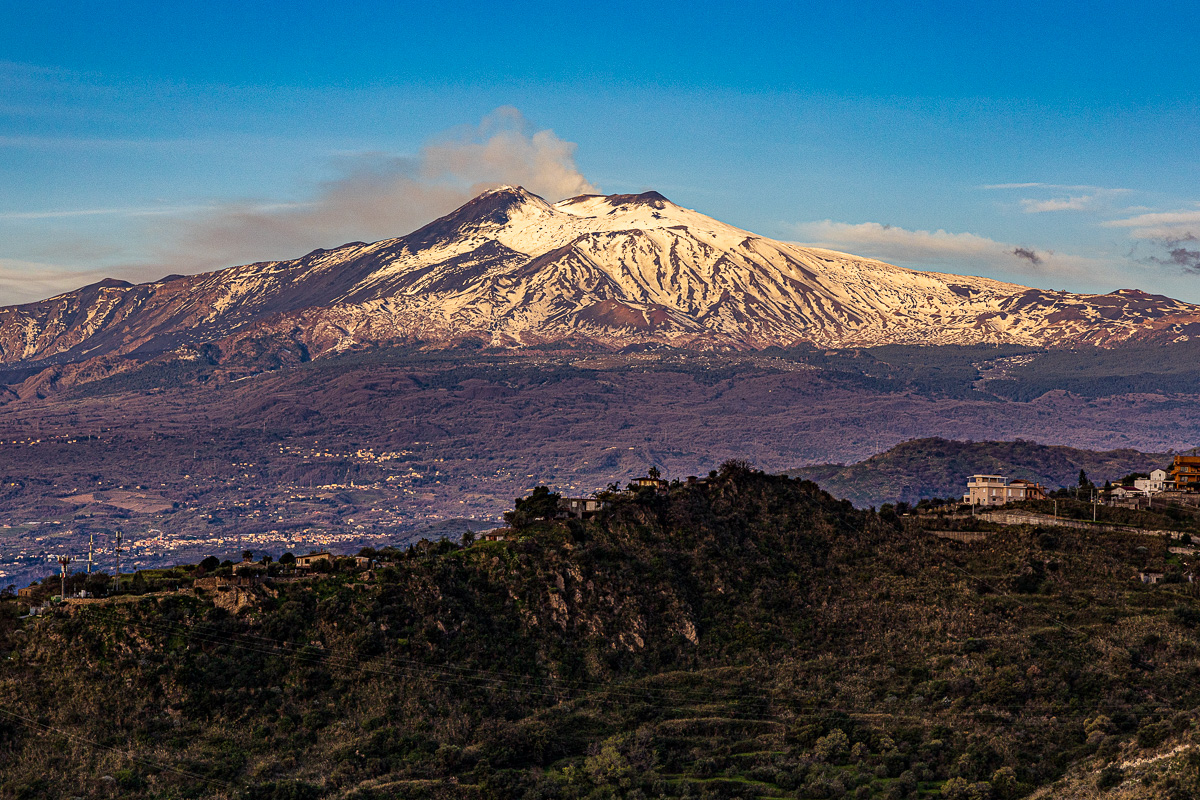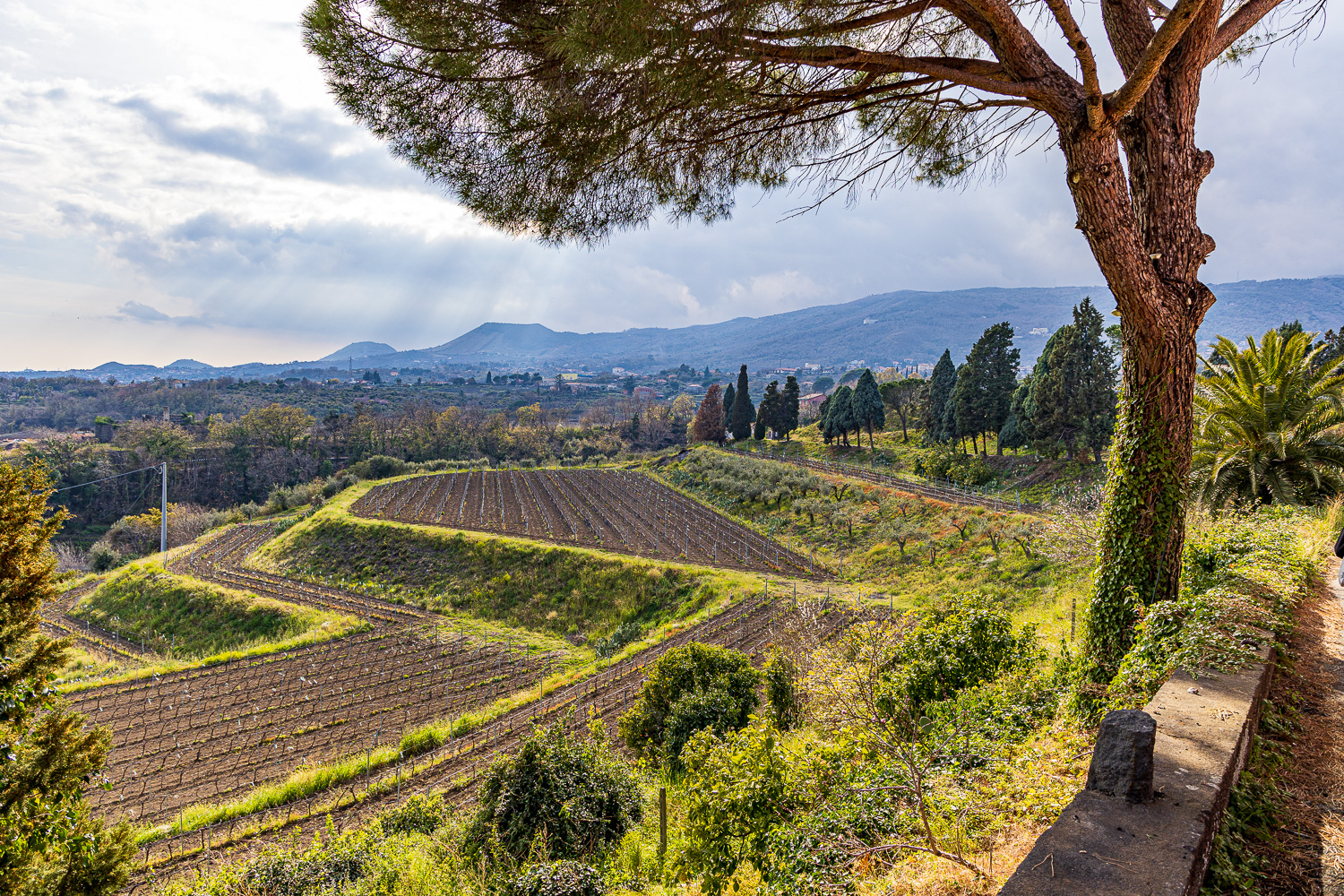Mt. Etna was located due west of our hotel. We knew it was there, but we’d not yet seen it. It was always hidden in the clouds. Finally, one morning as I walked out of the hotel to check out the view, there was Mt. Etna in all it’s glory! The warm early morning sun cast a nice color over the scene. According to Geology.com, “Etna’s current activity consists of continuous summit degassing,” so that might be steam rising from the crater in the photo below. This was the perfect day for the mountain to show up because it was the day we were heading up to pay it a visit.

After breakfast we climbed into a big, comfortable bus and headed out to Mt. Etna. This was our first outing via bus and it was interesting to note that Sicily’s mountainous terrain requires many highway tunnels and Sicilian bus drivers have to deal with many narrow streets. We eventually stopped in the city of Zafferana Etnea for a break. Some people went to look for a coffee shop. Some people went to look for a restroom. Some people went to look for a coffee shop with a restroom. I took a few photos.
Mouse over the small photos in galleries to see captions.
Click on any one to enlarge, then use arrows to scroll through the rest of the images.
It turns out that this was not just a random rest stop. Zafferana Etnea and Mt. Etna have a history. The largest eruption of Mt. Etna in the last 300 years started on December 15, 1991, and continued for 473 days. In 1992, Zafferana Etnea was seriously threatened by lava flowing from that eruption. Earthen dams were erected in an attempt to contain the flow but they only held for about a month. At the request of Italy, US Marine helicopters from carriers in the Mediterranean dropped huge concrete blocks in the path of the flow. Though not successful in stopping the flow completely, they slowed its progress long enough to dig a diversionary channel that eventually stopped the lava a half mile from the city limits.
Leaving Zafferana Etnea, we continued up to Mt. Etna National Park. When we pulled into the parking lot for the Silvestri Craters, fog had rolled in and there appeared to be nothing around but black lava covered in places with snow. Despite that first impression, there were many places where Sicilian Milkvetch grew in clumps scattered around on the surface. An artist in the parking lot was busy sculpting heads from the rough rock. Hiking up the Sylvestri Crater trail, more fog rolled in, turning the hikers in front of me into shadows in the mist. In places, the orange of oxidized iron added a little color to the trail. After enjoying the hike the well-heated bus was a welcome refuge from the cold, damp breeze.

There are certainly some disadvantages to living near a volcano, lava flowing towards your house and ash falling on you from the sky being two that come to mind. If you’re far enough from the active crater to feel relatively safe, however, there’s also one nice advantage. The soils that have evolved over the millenia are rich in minerals and incredibly fertile. When paired with the mild Mediterranean climate, this is an area that’s perfect for agriculture. Forbes Magazine says that “this land is appreciated for silence and beauty, as well as its excellent winemaking potential.” So, after leaving Mt. Etna National Park, we headed out to test some of that Sicilian wine.
We arrived at Tenuta San Michele where they have been producing Murgo Wines since 1860. Walking up the drive we could see the vineyard heeding its early spring wake-up call and stretching out under the sun. After looking around the grounds for a short while we were taken into the winery for a tour. We initially passed some large wooden barrels but most of their wine is fermented in stainless steel tanks, which are much easier to clean out and sterilize. Although the Wine Enthusiast reports that some wineries still stomp grapes by foot, Murgo Wines uses a modern method. An inflatable bladder inside the grape crusher slowly expands to push the juice through a screen. Doing this slowly avoids crushing the seeds, which would impart a bitter taste to the wine.
After the tour we went to the winery’s restaurant for lunch. This is usually the largest meal of the day in Italy and it’s a very leisurely event. Ours lasted two hours. By the time the waiters delivered all four courses — antipasto, primo, secondo, and dolce — it’s difficult to imagine having just a peanut butter and jelly sandwich for lunch. We expected wine of course; we’ve been served wine every day. What we didn’t expect, however, were five different wines. The glasses were not filled, but even five partial glasses of wine left me feeling very relaxed. I remember the waiter picking up a very large handful of empty wine glasses, but I don’t quite remember the bus ride back to Taormina.

<— Off to the Theater (Sicily Part 2) :: (Sicily Part 4) The Road to Siracusa –>